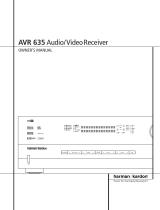
MAIN REMOTE CONTROL FUNCTIONS
On-Screen Display (OSD): Press this button to activate the
on-screen menu system.
Multiroom: Press this button to control the multiroom system.
Three settings are available: MULTI ON/OFF, which is used to turn the
multiroom system on or off; MULTI LEVEL, which adjusts the volume
of the remote zone only; and MULTI INPUT, which is used to select
the source input for the remote zone. See Multiroom Operation in
the Advanced Functions section for more information on using the
AVR 347’s multiroom system.
Channel Level: Press this button to adjust the output levels for each
channel so that all speakers sound equally loud at the listening position.
Usually this is done while playing an audio selection, such as a favorite CD,
after you have calibrated the levels using EzSet/EQ, as described in the Initial
Setup section.
Speaker Setup: Press this button to configure speaker sizes, that is,
the low-frequency capability of each speaker. Usually this is done using
the on-screen menu system, as described in the Initial Setup section.
Navigation (⁄/¤/‹/›) and Set Buttons: These buttons are
used to make selections within the on-screen menu system, or when
accessing the functions of the four buttons surrounding this area of the
remote – Channel Level, Speaker Setup, Digital Input or Delay.
Digital Input Select: Press this button to select the specific digital
audio input (or analog audio input) you used for the current source.
Delay: Press this button to set delay times that compensate for placing
the speakers at different distances from the listening position, or to
resolve a “lip sync” issue that may be caused by digital video process-
ing. This may also be done using the on-screen menu system, as
described in the Initial Setup section.
Numeric Keys: Use these buttons to enter radio station frequencies
or to select station presets. When the AM or FM band is in use, press
the Direct button before entering the station frequency.
When listening to XM Radio, you may enter channel numbers without
first pressing the Direct Button; however, use the Preset Stations
Selectors to access the preset stations. To access another bank of
XM presets, press the Set Button repeatedly until PRESET SEARCH
appears, then use the ⁄/¤Buttons to select the letter of the
desired bank.
Tuning Mode: When listening to AM or FM radio, this button toggles
between manual (one frequency step at a time) and automatic (seeks
frequencies with acceptable signal strength) tuning mode. It also toggles
between stereo and mono modes when an FM station is tuned.
When listening to XM Radio, press the Tuning Mode Button once to view
the category name of the current channel. Additional presses will display
the artist, song title and channel name.
Memory: After you have tuned a particular radio station, press this
button, then the numeric keys, to save that station as a radio preset.
For XM Radio, the procedure for saving a preset is a little different. To
save the current channel in one of the 40 available preset locations,
press the Set Button repeatedly until PRESET SEARCH appears. Use
the ⁄/¤Buttons to select a letter (A through E) representing one of
the five banks of preset memory slots. Then press the Memory Button,
followed by a Numeric Key (1 through 8) for the precise preset memory
location you wish to save the channel in.
Tuning: Press these buttons to tune a radio station or XM Radio
channel. For the AM and FM bands, and depending on whether the
tuning mode has been set to manual or automatic, each press will either
change one frequency step at a time, or seek the next frequency with
acceptable signal strength.
Direct: Press this button before using the Numeric Keys to directly
enter a radio station frequency (AM or FM bands only).
Clear: Press this button to clear a radio station frequency you have
started to enter.
Preset Stations Selector: Press these buttons to select a preset
radio station.
For XM Radio, first press the Set Button repeatedly until PRESET SEARCH
appears and then use the ⁄/¤Buttons to select the letter of the
desired bank of presets.
Tone Mode: Press this button to access the tone controls (bass and
treble). Use the Navigation Buttons to make your selections.
Disc Skip: This button has no effect on the receiver, but is used with
some optical disc changers to skip to the next disc.
Macros: These buttons may be programmed to execute long command
sequences with a single button press. They are useful for programming the
command to turn on or off all of your components, or for accessing special-
ized functions for a different component than you are currently operating.
Surround Mode Selectors: Press any of these buttons to select
a type of surround sound (e.g., multichannel) mode. Choose from the
Dolby modes, DTS modes, Logic 7 modes or Stereo modes. Each
press of a button will cycle to the next available variant of that mode.
Not all modes or mode groups are available with all sources.
Night Mode: Press this button to activate Night mode with specially
encoded Dolby Digital discs or broadcasts. Night mode compresses the
audio so that louder passages are reduced in volume to avoid disturbing
others, while dialogue remains intelligible.
Track Skip: These buttons have no effect on the receiver, but are
used with many source components to change tracks or chapters.
Dim: Press this button to partially or fully dim the front-panel display.
Transport Controls: These buttons have no effect on the receiver,
but are used to control many source components. By default, when the
remote is operating the receiver, these buttons will control a DVD player.
Backlight: Press this button to illuminate the buttons on the remote.
Press it again to turn the backlight off, or wait five seconds after the last
button press for the light to turn off on its own.
AVR347 harman/kardon






















